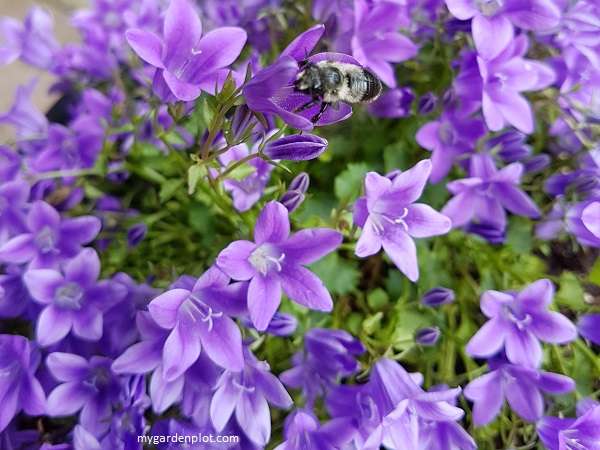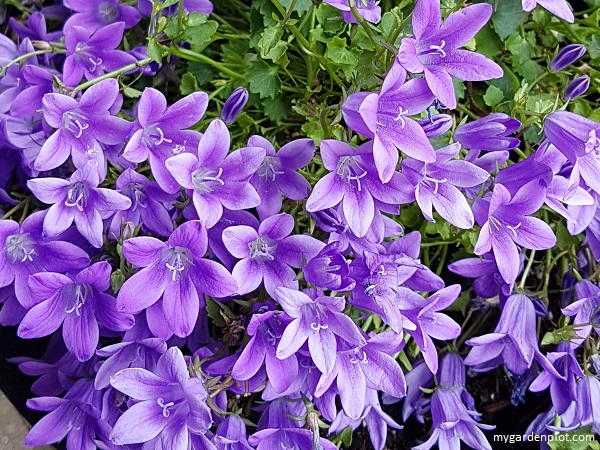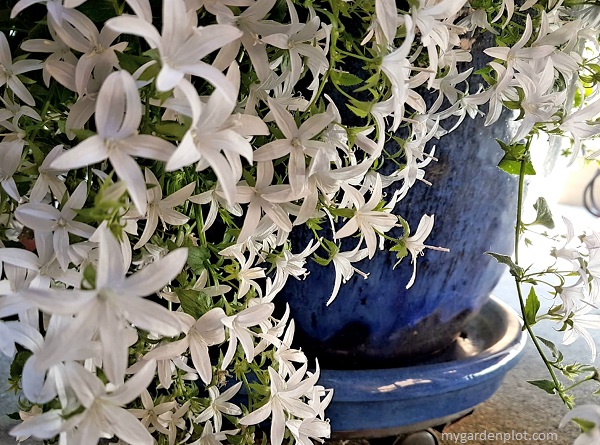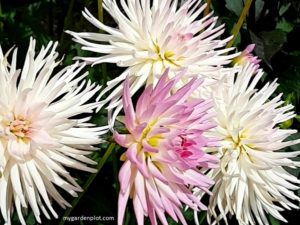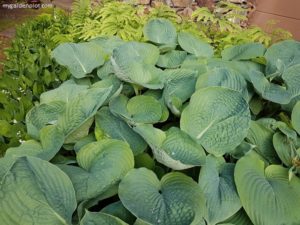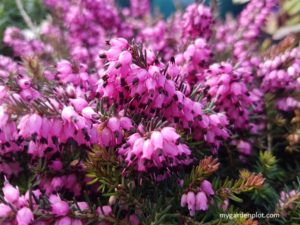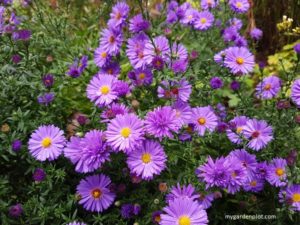About Campanula (Bellflower)
The Campanula or bellflower is a delicate-looking flower that is actually hardy. They are charming planted in stone crevasses, rock gardens, or bringing colour to a boggy meadow and a must for the quintessential English cottage garden. Very popular for ‘filling in’ the cracks along a stone path or draping over a wall. And most bellflowers are perfect for container gardening. Over 300 species originating from Asia, the Balkans, Europe, Japan, southeast Siberia, Turkey and North America (more below on native species). There is a bellflower for every garden, suitable for different conditions and plant hardiness zones. It would be challenging to cover them all on one page. Below are recommendations of our favourite bellflower varieties, along with tips on where to plant, and how to grow and care for them.
The bell or star-shaped flowers come in a range of colours, including white, hues of blues and purples, and pink. They flower sporadically from spring through to fall and occasionally during a mild winter. The profusion of flowers is a show stopper, and bees and hummingbirds love them. Some species, like the Campanula persicifolia, can be enjoyed as cut flowers too. Thankfully, campanulas are rabbit and deer resistant.
Is Campanula (Bellflower) Invasive?
Most campanulas are versatile, easy to grow perennials that may have an unlimited spread but easy to manage. Generally bellflowers that begin to spread beyond where you want them are easy to pull out. However, the Campanula rapunculoides is one of the vigorous spreaders that is invasive. It is best not to plant C. rapunculoides in the garden. Viewed as a ‘weed‘ with extensive, strong root system that is hard to remove. It is native to Europe and is also known as Creeping Bellflower, Rover Bellflower or Rampion Bellflower. Another campanula that can be invasive is the C. glomerata (Clustered Bellflower) though it is somewhat easier to control spread.
Campanula (Bellflower) At A Glance
Type: Perennials / Herbaceous / Semi-Evergreen (mild winters)
Conditions: Full Sun / Partial Shade
Blooming Season: Spring, Summer, Autumn
When To Prune: Autumn (see details below)
Size: Varies (see recommended campanulas below)
Plant Hardiness Zones: 2, 3, 4, 5, 6, 7, 8, 9
Where To Plant And How To Grow And Care For Campanula (Bellflower)
Most campanulas require fertile, moist but well-drained soil in a sunny location. Some species flower well in a part shady site. Other varieties almost thrive on gentle neglect, such as the C. poscharskyana (Serbian Bellflower) and C. portenschlagiana (Dalmatian Bellflower), which are happy in either sun or part shade, and practically any soil type. Most campanulas can adapt to different growing conditions except poorly drained or very acidic soil. Sunny days, with a little shade during summer, and cool nights are preferable. Below are more specific care tips for beautiful Campanula specifies and varieties recommended for gardens.
Plant new plants in spring, or sow seeds indoors in autumn or early spring. Most established campanula’s self-seed easily. Though some cultivars may not set seed.
Adding mulch in spring helps with preserving moisture and keeping their roots cool. For regions prone to strong acidic soils, a little lime mixed into the mulch can be beneficial. Regular water is needed, especially in summer.
To divide and move your campanula plant, simply split after flowering or later in the season in autumn or early spring and replant it where you want it. Due to their fibrous roots they have a tendency to wilt if damaged or do not receive enough water to re-establish.
For regions that receive a lot of rain, we recommend moving potted campanulas under the protection of an overhang during the winter months to limit saturation. They are tough; ours have occasionally looked worse for wear after cold, snowy weeks only to bounce back in spring as if nothing happened.
How To Prune Campanula (Bellflower) And Control Spread
If your bellflower plant spreads beyond where you initially wanted it, it is easy to manage. Most have fine roots that pull out without much effort.
Deadheading prolongs the flowering season. Though hardy plants, they are somewhat tender stemmed, and it is best to cut with scissors. By pruning about one-third of the plant, it encourages new growth and blooms.
Most campanulas benefit from trimming back height by half in early fall after flowering. While tall stemmed campanulas should be cut back to the ground by late fall.
RELATED TOPIC: Buyer’s Guide On How To Choose Hand Pruners (Secateurs)
Pest And Diseases That Affect Campanula (Bellflower)
Most likely, slugs and snails may trouble a campanula’s new foliage, though occasionally they can be affected by aphids or vine weevils. Diseases that can sometimes affect campanulas include powdery mildew and rust plant disease.
Recommended Campanulas (Bellflowers)
C. carpatica (Carpathian Harebell, Tussock Bellflower) – A beautiful low-growing border campanula. It is a herbaceous perennial native to the Carpathian Mountains. It has large upward-facing bell or cup-shaped flowers in blue, purple or white and blooms from late spring to early autumn. Suitable for rock gardens, edging and container gardening. The Carpathian Harebell is long-lived and reliable. It can spread but is not invasive. Grows to 30 cm (12 in) tall. Suitable for zones 3 – 9.
C. cochleariifolia (Fairy Timble Bellflower, Fairy Timbles) – The C. cochleariifolia, also sometimes spelled cochlearifolia, is native to Europe. Pale blue or bright lavender-coloured small bell-shaped flowers bloom throughout summer. This low-growing, almost ground-hugging alpine campanula produces masses of hanging flowers – perfect for edging, rock crevices and between paving stones. It is about 10 cm (4 in) tall and spreads easily. It needs to have moist, well-drained soil and prefers cool but sunny summers. It will need to be planted in a partially shady location where summers are hot. An important pollinator-friendly plant in the European Alps. Suitable for zones 2 – 9.
C. garganica (Adriatic Bellflower) – The Adriatic Bellflower is similar to the Serbian Bellflower but smaller. The violet-blue star-shaped flowers bloom late spring to autumn. It is native to Italy and Greece. It has a compact form with a height of about 5 cm (2 in), and the trailing flower stems look attractive over stone walls and rock gardens. It is drought tolerant and can survive planted in poor soil conditions and full sun. This semi-evergreen campanula is suitable for zones 4 – 9.
C. isophylla (Italian Bellflower, Falling Stars, Star of Bethlehem) – This campanula produces masses of flowers in blue, purple and white. It becomes bushy and round with hanging stems. Prefers a filtered sunny location and moist, well-drained soil. Dislikes full sun and bitter winters. Shelter from harsh cold wind. Better suited to mild winter climates. Suitable for zones 5 – 9.
C. lactiflora (Milky Bellflower) – An upright growth type native to the Caucasus or Caucasia region. The starry shaped flowers come in milky blue, white or pale pink, sometimes in darker blue and purple. It blooms from summer to early autumn. It can be a prolific self-seeder but easy to manage. Best planted in a partially shady area with moisture-retentive soil and protected from strong winds or stake tall stems to prevent damage. Grows to 120 cm (48 in) tall. Suitable for zones 4 – 9.
C. medium (Canterbury Bells) – Native to southern Europe, the popular C. medium is a sturdy campanula with tall stems. The large, bell-shaped flowers come in hues of blue, purple, pink and white. Perfect as cut flowers. Blooms from late spring. Plant in a sunny location and water regularly. Height of at least 60 cm (12 in). Suitable for zones 2 – 9.
C. persicifolia (Peach-Leaved Bellflower) – The C. persicifolia is an upright tall type native to Europe, North Africa and West Asia. Reaching up to 100 cm (40 in) tall. While the stems are sturdy, the flowers can sometimes bend the stems. A little support helps. Its large cup-shaped flowers come in pink, blue and white and bloom in summer. Perfect as cut flowers. Adaptable and tolerates poor soil. Suitable for zones 3 – 9.
C. portenschlagiana (Dalmatian Bellflower) – This long-lived alpine campanula is native to Southern Europe. This spreading dwarf type with a height of 15 cm (6 in) can be a moderately fast spreader, but it is not invasive. The deep purple flaring bell-shaped flowers bloom late spring through to the end of summer. Works well grown with snowdrops under rhododendron shrubs. Suitable for zones 4 – 9.
C. poscharskyana (Serbian Bellflower) – The Serbian Bellflower is one of our favourite campanulas. Small funnel-shaped flowers in deep purple or pure white. Masses of flowers bloom from late spring to early autumn. Dense growth and rampant spreader but easy to manage. Excellent for container gardening on its own with high impact yet low maintenance when potted. Spectacular trailing over a stoned wall. Hardy, drought-tolerant and reliable. Suitable for zones 5 – 9.

Pacific Northwest Native Campanulas
The Campanula lasiocarpa (Alaska Harbell, Mountain Harebell) is native to the Rocky Mountains and Alaska. It is low-growing, only to about 7.5 cm (3 in) tall. The violet-blue flowers are bell-shaped and bloom in summer. It naturally grows in moist, cool areas in the forest, meadows or rocky slopes.
The Campanula piperi (Piper’s Harebell, Olympic Bellflower, Olympic Harebell) is endemic to our immediate region of the Pacific Northwest, specifically the Olympic Mountains. This hardy small alpine and subalpine campanula grows mostly in rocky crevices and blooms mid to late summer. The saucer-shaped flowers are blue.
Also native to Pacific Northwest, as well as other regions in North America, is the Campanula rotundifolia (Bluebells Of Scotland, Bluebell, Harebell, Lady’s Thimble, Witches’ Bells, Round-Leaved Bellflower). It is an alpine type found in higher elevations. It has dainty pendant bluebells, and it can be invasive though slow-growing.
